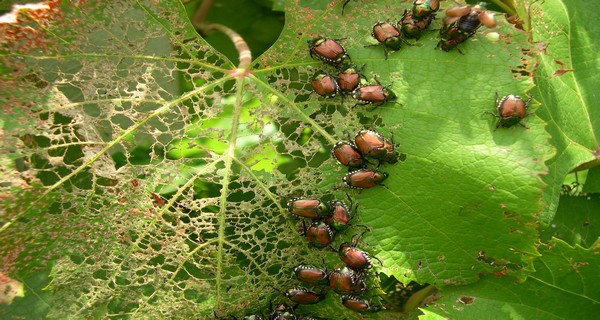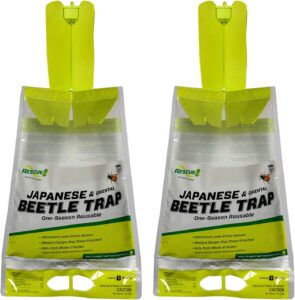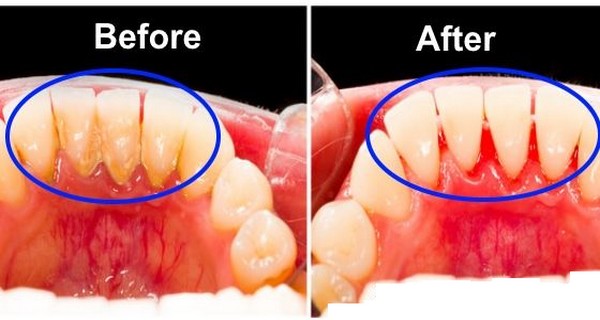Ad Blocker Detected
Our website is made possible by displaying online advertisements to our visitors. Please consider supporting us by disabling your ad blocker.

Here’s how to get rid of the insects without resorting to chemical insecticides.
Japanese beetles have the potential to cause extensive damage to your garden, particularly targeting roses, trees, and berry bushes. However, there are effective ways to eliminate these insects without relying on chemical insecticides.
Although Japanese beetles do not pose a direct threat to humans, their presence can be undesirable. These invasive insects feed on over 300 plant species and are responsible for costing the United States more than $460 million annually for management, as reported by Penn State Extension. They have a tendency to consume both plant leaves and flowers.
Despite being originally from Japan, these beetles are now widespread throughout much of the United States. Adult beetles display a distinctive metallic green or bronze hue on their backside and measure about 13 mm (½ inch) in length with copper-colored front wings.
When you spot one Japanese beetle, there is likely to be more in the vicinity. However, employing a few straightforward techniques can help you effectively eliminate Japanese beetles. Below, we will illustrate different strategies to rid your garden of these pests.
Before You Begin
Taking early action to prevent or eliminate Japanese beetles is crucial, as their population can quickly escalate, making eradication more challenging. These beetles are attracted to the scent of ripening or diseased fruits, which makes careful monitoring of your plants and promptly picking fruits and vegetables essential strategies to ward them off effectively. By implementing these practices, you can keep the Japanese beetles at bay and minimize their impact on your garden.
Signs of Japanese Beetle Infestation

Photo: istockphoto.com
Japanese beetles exhibit a voracious appetite for a wide array of plants, indulging in all parts, including fruits and flowers, leaves, and even roots. They particularly favor fruit-producing plants such as raspberries, grapes, apples, cherries, and plums. Additionally, they delight in feeding on trees like elm and birch, and they have a special affinity for roses.
The female Japanese beetles lay their eggs approximately 2 to 3 inches deep in the soil, where the resulting grubs will consume plant roots for sustenance before maturing into adult beetles.
To identify the presence of grubs, eggs, or adult beetles, closely examine the leaves of your trees, shrubs, and plants. A clear indication of a Japanese beetle infestation is the appearance of skeletonized leaves. These insects feed on the spaces between the major veins of the leaves, creating a lacy or skeleton-like pattern. Depending on the plant, the leaves might wither and drop off. Moreover, you might observe dead patches of grass where Japanese beetle grubs have decimated the root systems.
It is worth mentioning that Japanese beetles are typically found in groups. If you come across one on your plant, it is highly likely that several others are nearby. Taking prompt action to address these pests is essential to protect your plants and garden from further damage.
Protect Pollinators by Using Natural Methods for Japanese Beetles Removal
Rather than resorting to harsh chemical pesticides for a quick solution to eliminate Japanese beetles, choosing organic and natural remedies is a more responsible approach to safeguarding pollinators.
Pollinators, such as bees, butterflies, birds, and bats, play a crucial role in maintaining the health of ecosystems by facilitating the transfer of pollen, resulting in the production of fruits and seeds. According to the U.S. Forest Service, about 80 percent of the world’s flowering plants rely on pollinators for their reproduction.
The University of Missouri Integrated Pest Management program advises that the application of insecticides to control pests, including Japanese beetles, should be a last resort. Instead, when considering chemical control options, farmers and gardeners should opt for the lowest risk and most effective products to minimize the impact on pollinators and the environment. Prioritizing these natural and eco-friendly solutions can help protect the delicate balance of the ecosystem while effectively managing Japanese beetle populations.
9 Ways to Rid Your Garden of Japanese Beetles
Japanese beetles, much like certain other insects, can pose a significant nuisance in both your lawn and garden. As non-native species to the United States, they lack natural predators to keep their populations in check. If you encounter a Japanese beetle infestation in your yard or garden, consider employing one or more of the following methods to address the issue effectively.
1. Spray a homemade soap-and-water solution.
To suffocate Japanese beetles, you can create a straightforward mixture of water and dish soap. Prepare a bucket and blend a quart of water with a teaspoon of dish soap. For ease of application, transfer the soapy water into a spray bottle. Then, target the affected plants by spraying the Japanese beetles directly.
As a result, the beetles may fall off the plants, providing potential food for natural predators like birds. This non-harmful method can effectively control the Japanese beetle population in your garden.
2. Pick the Japanese beetles off plants by hand.
Getting rid of Japanese beetles can be as simple as using your hands. These insects are not fast movers, and they do not bite or pinch, making them easy to handle. You can pick them off the plants using your fingers (or wear thin gardening gloves if you prefer).
Once you have plucked a beetle from the plant, drop it into a bucket filled with the water-soap solution you prepared earlier. This hand-picking method provides an effective and direct way to control Japanese beetle populations in your garden.
3. Spray the affected plants with neem oil.
Neem oil serves as an effective solution to eliminate Japanese beetles even before they reach adulthood. Because neem oil is non-toxic, you can directly spray it onto your affected plants.
Here’s how it operates: When male beetles consume neem oil, they pass it on to the eggs. Consequently, the hatched larvae are affected and will eventually perish before maturing into adults. For optimal results, apply neem oil before the Japanese beetles reach adulthood, ensuring that they ingest it before the mating process begins. This approach proves to be an efficient method of eradicating Japanese beetles using neem oil without harming the environment or beneficial insects.
4. Set beetle traps away from targeted plants.
Using Japanese beetle traps is an excellent approach to prevent a Japanese beetle infestation from worsening. These traps function by attracting male beetles away from the affected areas, preventing them from mating.
Various traps are available for purchase, but their fundamental principle remains consistent. The trap contains an attractant, typically a pheromone, which acts as a chemical messenger to draw the insects towards it.
Once lured in, the beetles are either exterminated by a toxic substance within the trap or are unable to escape, ultimately leading to their demise. Employing traps is a strategic and effective method to manage Japanese beetle populations and minimize the damage they can cause to your garden or yard.
5. Use row covers during the peak feeding period.
Using a row cover can be a highly effective solution to prevent a Japanese beetle infestation before it even begins. These covers offer a protective barrier that keeps Japanese beetles out while still allowing light and some moisture to reach the plants, enabling them to thrive.
To achieve the best results, employ row covers during the peak feeding periods for the beetles, typically occurring from mid-June to mid-August. These covers come in various sizes and can be utilized on shrubs or trees, as well as placed over flowers, ornamental plants, or garden vegetables. By utilizing row covers strategically, you can create a physical barrier that effectively shields your plants from Japanese beetle damage and ensures their healthy growth.
6. Bring in parasitic nematodes to eat Japanese beetle grubs.
Nematodes are a type of parasitic roundworm that can live in a variety of environments and feed on everything from plants and bacteria to humans and animals. In the fight against Japanese beetles, certain nematodes can be used to control the pest in its grub stage.
Two genera of insect parasitic nematodes have been most actively considered for controlling Japanese beetles and other insect pests: Steinernema and Heterorhabditis, although only Heterorhabditis is commercially available. It can be purchased at most garden stores and online and is usually sold in a container that can be kept in cool conditions for up to 2 months. Just follow the instructions on the package and apply with any insecticide applicator.
7. Plant geraniums close to the plants you want to protect.
Incorporating a specific plant into your garden can be an effective method of controlling Japanese beetles. Scientists have found that geraniums serve as a natural deterrent, helping to protect nearby plants from the destructive actions of these bothersome insects.
According to the U.S. Department of Agriculture, when Japanese beetles consume geranium petals, a remarkable effect occurs. Within 30 minutes, the beetles become paralyzed, rolling over on their backs, with their legs and antennae twitching. This state of paralysis can last for several hours. While the beetles typically recover within 24 hours, their vulnerability during this time makes them easy prey for predators that spot and consume them. Consequently, many of the beetles succumb to death while they are in this helpless state.
By incorporating geraniums into your garden, you can take advantage of this natural defense mechanism to deter and control Japanese beetle populations effectively.
8. Prune rose buds and treat rose bushes before they bloom.
To safeguard your cherished rose bushes from the devastation caused by Japanese beetles, a proactive approach involves pruning rose buds and treating the bushes before they bloom.
After the initial bloom, consider pruning the roses more extensively than usual to ensure that any lingering beetles are eliminated before the next flush of flowers appears. Once the pruning is complete, manually remove any remaining beetles from the plants.
Furthermore, you have the option to protect your rose bushes by using a mesh covering, which can be easily found at most gardening stores. Alternatively, spraying affected plants with neem oil proves effective in preventing lingering grubs from reaching adulthood and causing further damage. Employing these measures can significantly reduce the impact of Japanese beetles on your prized rose bushes and maintain their health and beauty.


